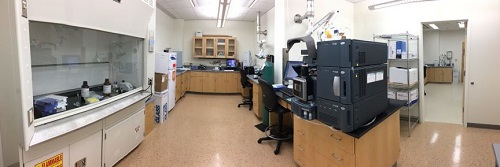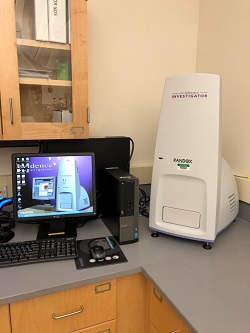The VFL utilizes an instrument called a Randox Evidence Investigator using an immunoassay method to screen samples for:
| Meth / Amphetamines | Meprobamate |
| Barbiturates | Methadone |
| Benzodiazepines | Opiates |
| Buprenorphine | Opioids |
| Cannabinoids | Phencyclidine |
| Cocaine Metabolite | TCA |
| Dextromethorphan | Tramadol |
| Fentanyl | Zolpidem |
As a scientific and forensic guideline, the initial identification of a drug, or drugs, should be confirmed by a second technique based on a different chemical principal. The VFL confirms samples that screen positive for Cannabinoids, Opiates/Opioids, Fentanyl, Stimulants, and Benzodiazepines using High Performance Liquid Chromatography/Tandem Mass Spectrometry (LC-MS/MS). If confirmation is required for other analytes , samples will be sent to NMS Labs in Willow Grove, PA for testing.



Blood Drug FAQ
What is a drug?
Any substance or combination of substances, other than alcohol, which affects the nervous system, brain, or muscles of a person so as to impair, noticeably and appreciably, a person's ability to drive a vehicle safely.
What is a blood drug concentration?
The amount of drug and/or drug metabolite present in your blood. This is typically reported in nanograms of drug per mL of whole blood.
What method of testing blood drugs is used at the Vermont Forensic Laboratory?
Samples are screened for classes of drugs using immunoassay and drugs are confirmed and quantified using Liquid Chromatography/tandem Mass Spectrometry (LC-MS/MS).
What is the preferred blood collection tube to use when submitting evidence to the Vermont Forensic Laboratory?
Gray topped tubes containing anticoagulant and preservative, which are found in VFL issued blood collection kits.
Where do agencies get blood collection kits?
These kits are made available to all local and state agencies through the Vermont Forensic Laboratory.
What is the legal drug level in Vermont?
There is not a numerical per se limit regarding blood drug concentrations. The law states “A person shall not operate, attempt to operate, or be in actual physical control of any vehicle on a highway… when the person is under the influence of any other drug or under the combined influence of alcohol and any other drug. ‘Under the influence of a drug’ means that a person's ability to operate a motor vehicle safely is diminished or impaired in the slightest degree.”

